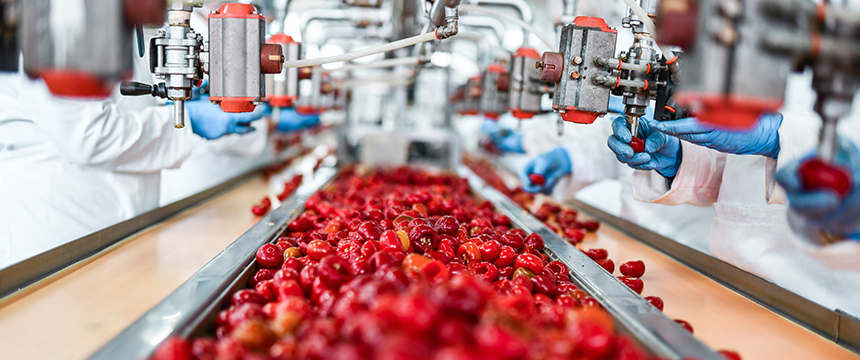
We invite you to enjoy a review of the food and beverage industry with bite size articles ranging from regulatory and real estate trends to litigation and M&A happenings.
The past two years have seen significant changes in almost all industries and the food and beverage industry has unquestionably been impacted by the pandemic as well. However, as we transition into whatever “new normal” awaits us in 2022 and beyond, we already are seeing regulatory and legal changes that reflect this transition into the next phase. Entities such as Congress, the Department of Justice, and others are looking both backwards (as stewards of money already spent) and as well as looking forward to plan for dealing with COVID over the long term. We also see that some things, like food litigation and M&A activity, have leveled and show that even as some things change, others remain constant.
The bottom line is that keeping your finger on the pulse of what is around the corner remains as important as ever.
Table of Contents
FDA Resumes Routine Surveillance Inspections
| AUTHORS | |||||
| Nate Beaver | nbeaver@foley.com | |||||
| Nick Johnson | njohnson@foley.com | |||||
Companies should be aware that FDA has resumed routine surveillance inspections of registered food facilities on February 7, after temporarily putting them on pause in late December 2021 due to the spread of the omicron variant of COVID-19. The FD&C Act requires FDA to inspect domestic food facilities either once every three years or every five years (depending on whether a facility is “high-risk” or not), but FDA’s inspection activities over the past two years have been severely hampered by the ongoing COVID-19 pandemic. In March 2020, at the onset of the pandemic, FDA limited its inspections to “mission-critical” issues – for example, those related to foodborne illness outbreaks – which generally did not include routine surveillance visits. Throughout 2021, FDA completed only a fraction of the human and animal food domestic surveillance inspections it had planned. With FDA’s February 2022 announcement, food facilities should anticipate a visit from the agency in 2022 – especially if it has been several years since the last visit, or if a facility’s last FDA inspection identified critical items for resolution or follow-up.
FDA releases updated list of forthcoming documents
In June 2021, the FDA’s Center for Food Safety and Applied Nutrition (CFSAN) and Office of Food Policy and Response (OFPR) released a priority list of draft and final guidance topics that the FDA Foods Program intends to complete by June 2022. In January 2022, the FDA released an updated list, which is available here. Stakeholders may submit comments on the guidance topics via www.regulations.gov at Docket FDA-2021-N-0553. Forthcoming guidance documents of note include:
- Premarket Consultation on Cultured Animal Cell Foods: Draft Guidance for Industry
- Foods Derived from Plants Produced Using Genome Editing: Draft Guidance for Industry
- Labeling of Plant-Based Milk Alternatives: Draft Guidance for Industry
- Labeling of Plant-Based Alternatives to Animal-Derived Foods: Draft Guidance for Industry
- Action Levels for Lead in Food Intended for Babies and Young Children: Draft Guidance for Industry
- In April, FDA published a new draft guidance on allergens entitled “Evaluating the Public Health Importance of Food Allergens Other Than the Major Food Allergens Listed in the Federal Food, Drug, and Cosmetic Act,” available here.
FDA releases action plan for reducing toxic metals exposure in baby food
In October 2021, the FDA released its Closer to Zero action plan, which identifies actions that the agency will take to reduce exposure to toxic heavy metals (such as arsenic, lead, cadmium, and mercury) that can be present in food intended for babies and young children. The plan comes on the heels of a 2021 U.S. House of Representatives committee report which concludes that commercial baby foods are tainted with “significant levels” of toxic heavy metals.
Elements of the action plan include further research on dietary exposure to toxic elements, encouraging industry best practices; setting action levels with input from stakeholders, and increased targeted and compliance activities. As noted above, FDA proposes to issue draft guidance on action levels for lead in baby food in 2022.
Government Enforcement Defense & Investigations
| AUTHOR | |||||
| Lisa Noller | lnoller@foley.com | |||||
The “accommodations and food services” industry was the largest recipient industry of Paycheck Protection Program (PPP) funds. Under the Program, eligible small businesses could apply for low-interest private loans to cover costs associated with keeping their workforce employed, including payroll costs, rent, interest, and utilities. With approximately $799 billion in loans approved under the PPP, the Government is keen to prosecute any inappropriate activity. While the Department of Justice (DOJ) has, so far, mainly focused on criminal cases, civil enforcement is also on the rise. Criminal cases tend to be more cut-and-dry; the rise of civil enforcement means companies who made close calls and used their discretion as to eligibility criteria and use of funds may find themselves under scrutiny.
DOJ is conducting data analytics to identify anomalies in PPP applications, and issuing Civil Investigative Demands under the False Claims Act to examine data anomalies as well as to investigate concerns raised by individuals or competitors who stand to recover a monetary bounty as whistleblowers, should the government recover funds from an applicant due to its alleged or actual violation of PPP requirements. Additionally, the Small Business Association is proactively auditing loans, and has stated that all loans are undergoing an automated review process and any loan of $2 million or more will undergo a manual review.
The False Claims Act imposes treble damages and civil penalties on any person or entity who knowingly (or with reckless disregard or deliberate ignorance) made a false claim or statement that was material to a government payment decision. An entity which incorrectly certified as a small business eligible for PPP funds, or which misspent PPP funds, may find itself under investigation and facing False Claims Act exposure. Importantly, that an entity violated program requirements is not—in itself—a violation of the False Claims Act. Entities who receive demands or requests for information from the Government should consult with experienced outside counsel.
Real Estate
| AUTHOR | |||||
| Donna Pugh | dpugh@foley.com | |||||
Ubiquitous in the retail food and beverage industry is a trend to offer delivered meals, groceries and liquor, brought about by pandemic-related closures and safety concerns. As businesses strive to quickly accommodate customer demands, municipalities have been slower to adapt to changing business models. This presents numerous challenges, not least of all with land use and zoning compliance. While many municipalities have embraced food delivery from existing restaurants, they have been slower to permit third-party delivery services for food, liquor, groceries, or even cannabis (where state laws allow). Municipalities have not been quick to accommodate “dark stores” or “ghost kitchens” with a sole purpose of preparing food for delivery. However, the demand for quick delivery services necessitates such “delivery facilities.”
When it comes to delivery facilities, the age-old adage of “location, location, location” applies more than ever. However, when municipalities consider such facilities “warehouses” and push them to the manufacturing-zoned districts, it can easily add 10-15 minutes on to each delivery time. Conversely, delivery facilities that are in the commercial districts struggle to comply with parking and building design requirements meant for patrons that will never enter the premises.
While, municipalities are keen to embrace new businesses, they are hesitant to risk a proliferation of non-pedestrian oriented storefronts. As such, working with stakeholders to draft amendments of municipal codes is equal parts legislation, and politics, and having the right team will make all the difference.
Litigation
| AUTHOR | |||||
| John Zabriskie | jzabriskie@foley.com | |||||
The upward trend in the number of new putative consumer class actions alleging misleading food labeling continued in 2021. Many of these cases were filed in traditional hot bed venues such as the Northern District of California (the “Food Court”), and an increasing number were filed in courts in the Midwest, especially Illinois.
Courts continue to scrutinize challenged labels through the eyes of the “reasonable consumer”—a judicially imagined person deemed representative of a significant portion (though less than 50%) of the target consuming public acting reasonably in the circumstances. While all of the information on a package and the context in which it is presented is considered, a reasonable consumer generally is not required to test an ambiguous front label claim against additional information on the back label, particularly for lower priced items. Bell v. Publix Super Markets, Inc., 982 F.3d 468, 476 (7th Cir. 2020). While it may be too early to conclude that courts are requiring an increased level of scrutiny by the reasonable consumer, rulings from 2021 suggest that manufacturers may succeed in obtaining early disposition of claims at odds with a common sense label interpretation.
Some of the most common types of label claims challenged in 2021 include:
- Claims that words such as “vanilla” and “strawberry” are misleading because the products do not include those ingredients. Many of these cases were dismissed on the grounds that reasonable consumers understand such words when used alone to simply describe the product’s flavor, as opposed to identifying the primary ingredient providing that flavor. See, e.g., Tropp v. Prairie Farms, No. 20-cv-1035-jdp, 2021 WL 5416639 (W.D. Wis. 2021). But adding a word or image might change the result. See, e.g., Rudy v. Familiar Dollar Stores, Inc., No. 21-cv-3575, (N. D. Ill. Feb. 4, 2022) (denying motion to dismiss claim that “smoked almonds” label description was misleading because the smoked flavor derived from liquid smoke, not roasting over an open fire).
- Claims that labels overpromised the number of servings that can be made from one container. One case was dismissed on the grounds that a claim of “up to” a number of servings was only a ceiling not a floor, Brodsky v. ALDI, No. 20 C 7632, 2021 WL 4439304 (N.D. Ill. 2021), but another case held that similar language could be misleading if there was a “huge disparity” between the number of servings a consumer could make by following the canister’s instructions and the amount referenced on the label. In re: Folgers Coffee, Marketing Litigation, No. 21-2984-MD-W-BP, (W.D. Mo. 2021). A “servings” case was settled for $16 million and a commitment to modify its serving label claim. Ferron v. Kraft Heinz Foods Co., No. 0:20-cv-62136, (S.D. FL). The lessons of these cases readily apply to many other food products.
Other types of claims challenged in 2021 were:
- Claims that a product was free of preservatives or artificial flavors when certain dual-use ingredients could have been used as preservatives or as flavoring.
- Claims alleging that the location used in the manufacturer’s name implied the product originated there when it actually originated elsewhere.
- Claims challenging a label’s claim that a product derived from “sustainable” practices when they are alleged to have been made from industrialized farming.
Noteworthy settlements in 2021 involved cases alleging that healthfulness claims were misleading in light of the products’ sugar content. See McMorrow v. Mondelez, No. 3:17-cv-02327 (S. D. Cal.) (breakfast bars, $8 million); Krommenhock v. Post Foods, LLC, No. 16-cv-4958-WHO (N.D. Cal.) (cereal, $15 million); Hadley v. Kellogg Sales Co., No. 5:16-cv-04955 (N.D. Cal.) (cereal, $13 million). In this context, it is interesting that the FDA announced plans in 2021 for a revised definition of “healthy” and revised requirements for when that implied nutrient claim can be voluntarily used on human food product labels. The FDA also announced that it was conducting research into a “healthy” symbol.
Food & Beverage Policy in 2021 and What to Look for in 2022
| AUTHOR | |||||
| Jared Rifis | jrifis@foley.com | |||||
The American Rescue Plan, signed into law on March 11th, 2021, was a $1.9 trillion piece of legislation that provided economic relief across a variety of sectors. Within the bill was the creation of the Restaurant Revitalization Fund. Administered by the Small Business Administration, the program was designed to keep restaurants open through the pandemic. The program provided funding for pandemic-related revenue loss up to $10 million per business and up to $5 million per physical location. The funding for this program ran out in October 2021.
The American Rescue Plan also included $350 billion for state, local, and tribal governments to address the fiscal impacts of the pandemic. 25% of these funds were designed to be devoted for hospitality industry relief.
With less than 200 days until 2022 midterm elections, Congressional leaders are looking to provide another round of COVID relief for small businesses. Senators Ben Cardin (D-MD) and Roger Wicker (R-MS) have led the effort this time. The $48 billion package has a multitude of Democrat co-sponsors, but Wicker remains the only Republican co-sponsor. The bulk of the package, $40 billion, is designed to replenish the Restaurant Revitalization Fund. Senate Finance Chairman Ron Wyden (D-OR) said in a statement that he “strongly support(s) this package.” The package has been a part of ongoing negotiations for the past few months and could likely see a vote in the near future.
However, another round of COVID relief comparable to the levels of the American Rescue Plan is unlikely in 2022. The White House has stated that there may be additional relief to restaurants and the hospitality industry, but cited economic growth as the reasoning behind not pursuing another major COVID relief package. After removing a new round of COVID relief as a part of the government funding negotiations for FY2022, Congress is now currently negotiating another round of COVID relief as an attachment to supplemental aid to Ukraine.
M&A
| AUTHOR | |||||
| Bryan Schultz | brschultz@foley.com | |||||
After a pause in the early days of the pandemic, M&A activity in the food and beverage industry rebounded in 2021. Speculation around a potential capital gains tax rate increase, owner fatigue due to the difficulty of managing through the pandemic, continuing pandemic-related business challenges, and other factors often fueled sellers, while buyers frequently sought opportunities in light of low interest rates, sizable cash holdings, and the potential for significant growth as the world emerged into a new normal.
In general, the business of companies operating in the grocery and food distribution channels was positively affected by the pandemic. Similarly, many companies in the beverage sector, including the off-premise beer, wine, and spirit sector, experienced significant growth. As a result, the pandemic frequently presented opportunity for an attractive exit for owners of these types of companies in 2021. By comparison, restaurants and similar hospitality companies often experienced considerable challenge due to the pandemic, and while many owners sought an exit, M&A transactions proved difficult in these sectors.
In both environments – M&A activity involving thriving food and beverage companies and M&A activity involving struggling food and beverage companies – certain general themes arose in 2021. In many cases, buyers and sellers experienced difficulty in assessing valuations. In the case of thriving companies, buyers experienced challenges with determining the long-term viability of the growth driven by the pandemic. In the case of struggling companies, sellers often sought to convince buyers to look past short-term struggles with an eye toward long-term forecasts after the pandemic impacts ease. In addition, novel pandemic EBITDA adjustments required discussion. Often, the resulting valuation gaps required lawyers to help companies identify a deal structure solution, including, at times, the implementation of complex earn-out and similar mechanisms.
The growing use of representation and warranty insurance as a means of mitigating post-transaction liability risk aided sellers in 2021. However, insurers were mindful of the novelty of the ever-changing pandemic environment. As a result, many policies involved pandemic-related exclusions from coverage. At times, that circumstance resulted in extensive negotiations between buyers and sellers with respect to the allocation of pandemic-related risk. While many buyers accepted the risk of the unknown presented by the fluid environment, the topic often involved significant dialogue.




